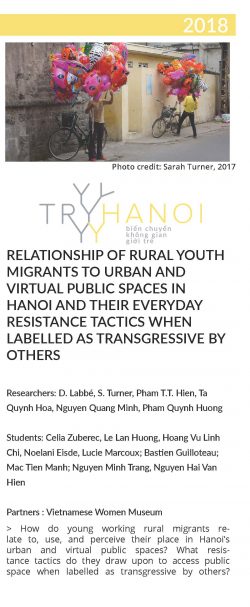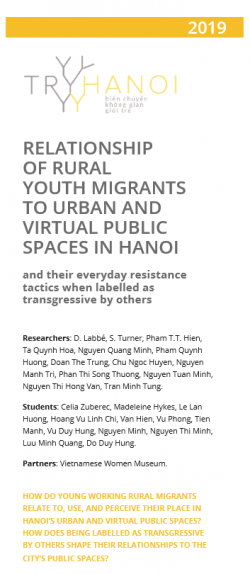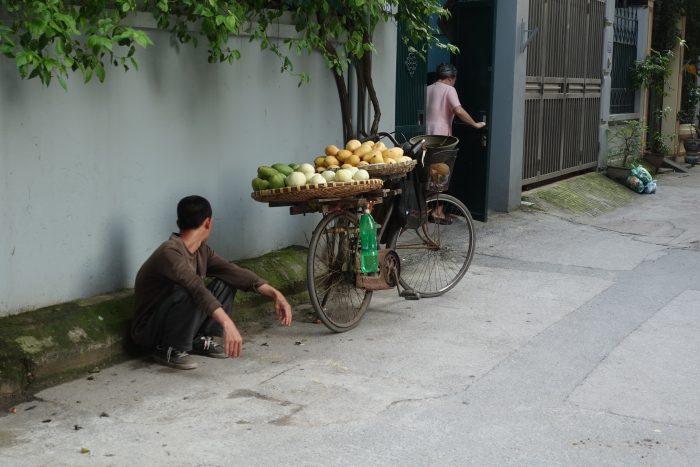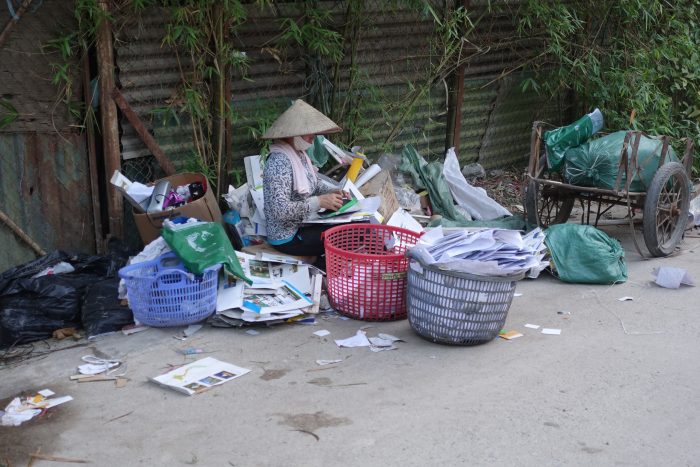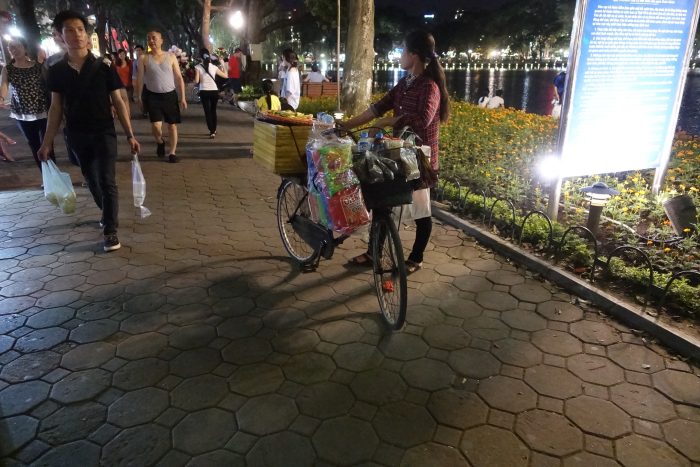Relationships of rural youth migrants to urban and virtual public spaces in Hanoi and their everyday resistance tactics when labelled as transgressive by others
hanoi
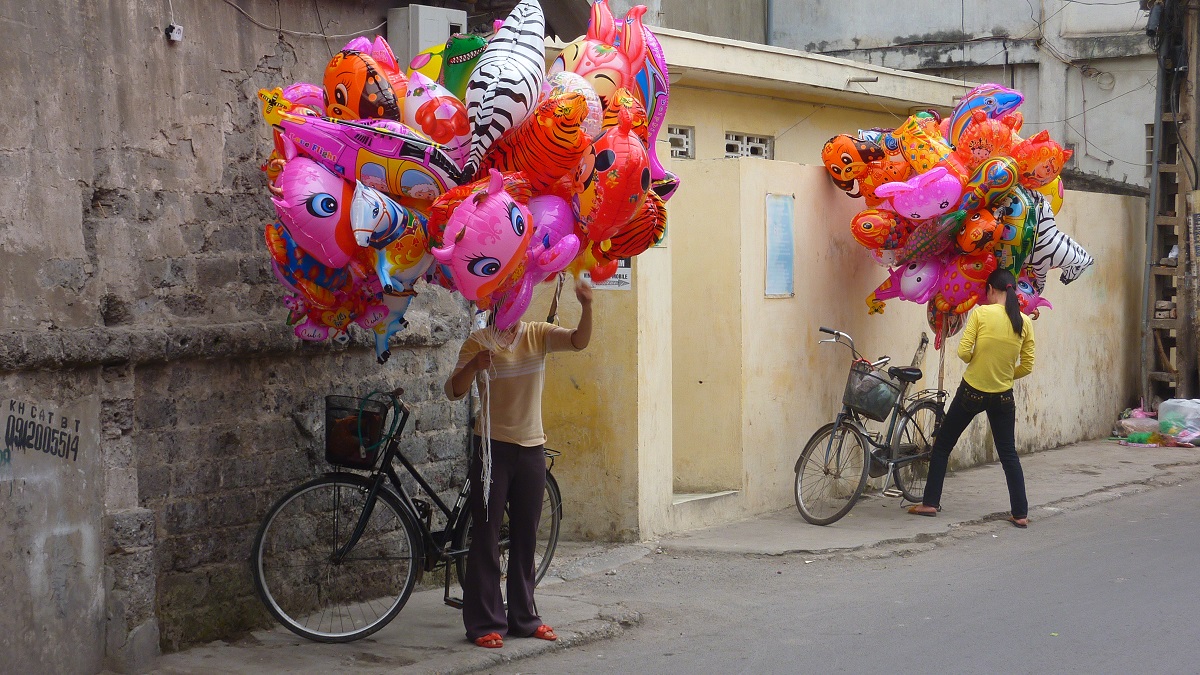
How do young working rural migrants relate to, use, and perceive their place in Hanoi’s urban and virtual public spaces? What resistance tactics do they draw upon to access public space when labelled as transgressive by others?
Hanoi has been attracting a steady flow of migrants over the past twenty years since internal migration restrictions (hộ khẩu – household registration) were eased in the 1980s and 1990s. It is estimated that about 100,000 internal migrants move to Hanoi every year and that over half do so to find work. This is a relatively young population, especially in the case of recent migrants, the vast majority of whom are between 15-25 years old.
The Government’s Ministry of Labour, Invalids and Social Affairs (MOLISA) identifies four main groups/categories of (non-student) migrants whom we focus upon in this case study:
- Factory workers
- ‘Free’ workers employed by small service businesses (e.g. restaurant and café workers, hairdressers)
- Domestic helpers (e.g. maids, nannies, security workers)
- Independent labourers (e.g. street vendors, construction site workers).
Young rural migrants belonging to these four categories often live in difficult material conditions characterized by low salaries and a lack of social protection (such as protection from harassment), limited or no access to basic public services such as health care or education (often due to Vietnam’s household registration system’s rules), and poor housing conditions.
The presence of young rural migrants in the city is frequently considered by other urban residents, especially long-term residents, as problematic. Rural migrants are often believed by other urban residents to have undesirable attributes or characteristics such as low socioeconomic status, a ‘backwards’ rural accent, undesirable appearances, and poor behavior. Moreover, migrants are often viewed as making the city dirty, polluted, noisy, and disordered, while others complain that migrants make the city overpopulated and congested, as well as unsafe. Limited research to date has shown that many rural migrants feel that they are being looked down by urbanites and consider themselves ‘outsiders’ in the city. This social stigma, combined with institutional discrimination, causes social exclusion, a lack of a sense of belonging, and negatively impacts well-being and mental health.
Aim: to investigate the relationships of rural youth migrants (16-25) to urban and virtual public spaces in Hanoi and the everyday resistance tactics that they draw upon to access public space when labelled as transgressive by others.
Research questions:
1. Relationships with and use of public space: How do young rural migrants relate to Hanoi’s socio-spatial environment? In particular, which public spaces do they access and which do they avoid, and why? How do they use (or not) the city’s different public spaces?
2. Young rural migrants’ perceptions of other urban residents: Do young rural migrants to Hanoi feel labelled or stigmatized by other urban residents? If yes, how does this play out and how do migrants cope with (or react to) such labelling/stigmatization? Moreover, how do different groups of rural migrants (factory workers, street vendors, domestic aid, etc.) perceive each other?
3. Urban residents’ perceptions of young rural migrants: How do urban residents perceive young rural migrants, especially with regards to their presence/activities in urban public spaces?
4. Impacts of perceptions of others on young rural migrants’ public space use: If young rural migrants feel labelled or stigmatized by other urban residents (either long-term residents or other migrants) does this impact how specific groups of young rural migrants use and behave in the city’s public spaces? More specifically, do these behaviours include what these youth or other residents would term transgressive acts?
What could the transgressive acts of young rural migrants look like as they try to access public spaces?
- Street vendor in Hanoi. Credits: S. Turner
- Street vendor in Hanoi. Credits: S. Turner
- Street vendor in Hanoi. Credits: S. Turner
Street vending example
In 2008, the People’s Committee of Hanoi banned street vending on 62 selected streets and in 48 public spaces in the urban core. This ban has impacted street vendors differently depending on their origin and degree of mobility. Itinerant vendors – overwhelmingly migrants from peri-urban zones and rural villages – are most commonly targeted by authorities enforcing the 2008 decree. With street vending now one of their few remaining livelihood options, these individuals – mostly women, and often young – have to find ways to outmaneuver officials. In contrast, Hanoi’s resident, fixed-stall vendors are far more likely to broker an arrangement with local ward officials, settling upon regular bribes or ‘taxes’ to maintain their right to trade.
Itinerant street vendors, young and old, deal with the 2008 ban with their own ‘take’ on what forms of legislation and control are just and equitable. The vending ban is implemented and enforced at the ward (phường) level, the lowest subdivision of local urban administration. As such, part of the transgressive acts of itinerant street vendors includes understanding and interpreting the spatial practices and surveillance gaps of the Công an (local ward police). One such gap occurs along the borders between wards; itinerant vendors have realized that they can quickly cross a boundary to escape ward police, who are not authorized to pursue vendors outside their jurisdiction to confiscate their goods or fine them.
Itinerant traders also know which streets and other public spaces are most likely to be targeted by police: larger thoroughfares are more commonly patrolled and smaller streets and alleyways less so. Itinerant vendors therefore draw upon spatial routines and social networks to protect their existing access to urban public spaces as much as possible. Traders have also been quick to learn the routines of local police and rework their own schedules accordingly. On weekdays, an important trade opportunity occurs at noon when the Công an take their lunch break, allowing traders to enter areas like the Ancient Quarter that are usually highly monitored.
These findings come from research that members of the Hanoi TRYSPACES team have already completed. But what we don’t yet know is what are the specific tactics (if any) of younger migrant itinerant street vendors? Do they follow the practices of those older than them and learn the tricks of the trader that way? Or are they coming up with their own, innovative solutions, perhaps linked to their use of new technology (smart-phones) and ease of mobility? This is one such project that our team will carry out…
Here is the case study summary sheet for 2021:
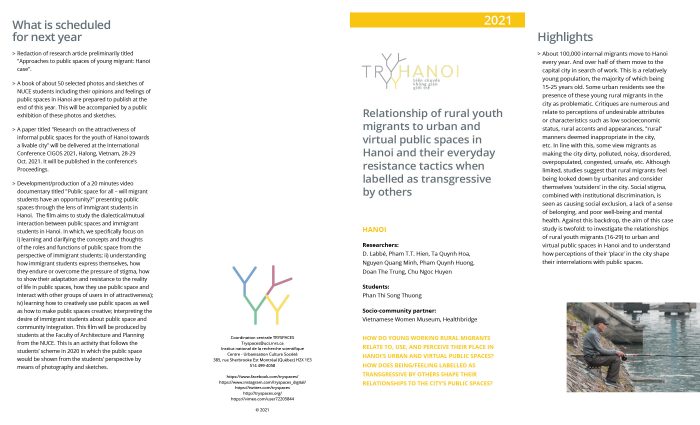
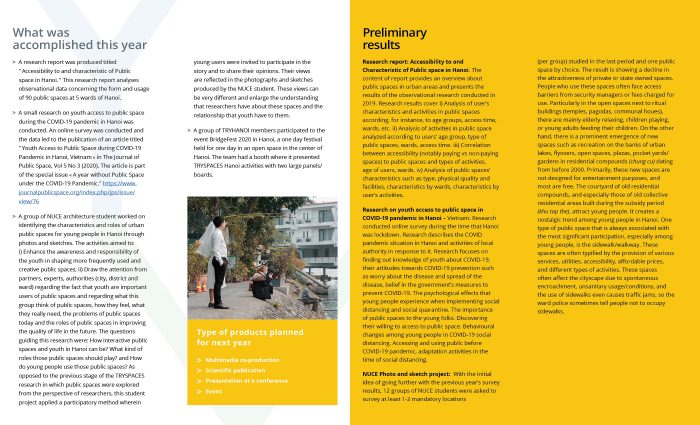
Click here for 2021 A4 format printable version and the 8.5 x 11 format printable version.
Click here for 2020 A4 format printable version and the 8.5 x 11 format printable version.
Click here for 2019 A4 format printable version and the 8.5 x 11 format printable version.
Click here to consult the web version of the case study summary sheet for the year 2018 and here for the printable version.
